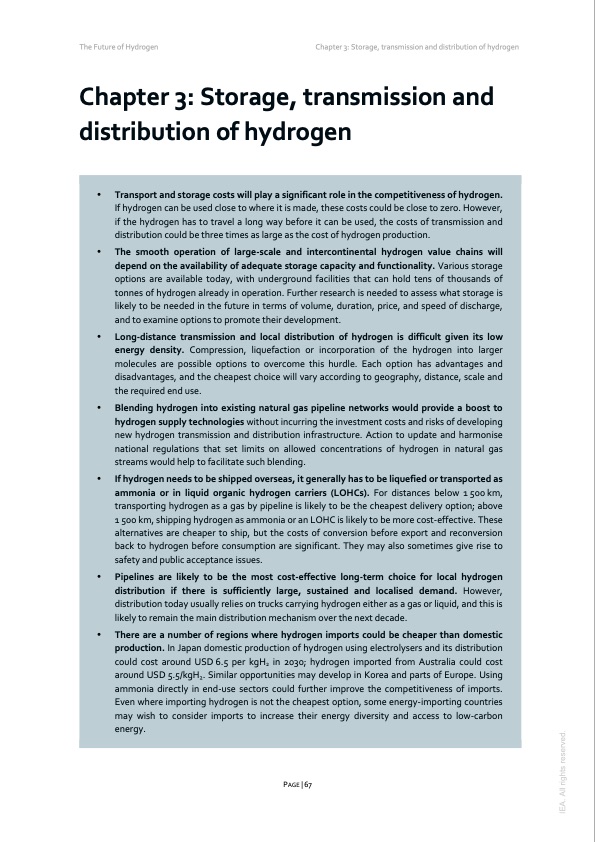
PDF Publication Title:
Text from PDF Page: 067
The Future of Hydrogen Chapter 3: Storage, transmission and distribution of hydrogen Chapter 3: Storage, transmission and distribution of hydrogen Transport and storage costs will play a significant role in the competitiveness of hydrogen. If hydrogen can be used close to where it is made, these costs could be close to zero. However, if the hydrogen has to travel a long way before it can be used, the costs of transmission and distribution could be three times as large as the cost of hydrogen production. The smooth operation of large-scale and intercontinental hydrogen value chains will depend on the availability of adequate storage capacity and functionality. Various storage options are available today, with underground facilities that can hold tens of thousands of tonnes of hydrogen already in operation. Further research is needed to assess what storage is likely to be needed in the future in terms of volume, duration, price, and speed of discharge, and to examine options to promote their development. Long-distance transmission and local distribution of hydrogen is difficult given its low energy density. Compression, liquefaction or incorporation of the hydrogen into larger molecules are possible options to overcome this hurdle. Each option has advantages and disadvantages, and the cheapest choice will vary according to geography, distance, scale and the required end use. Blending hydrogen into existing natural gas pipeline networks would provide a boost to hydrogen supply technologies without incurring the investment costs and risks of developing new hydrogen transmission and distribution infrastructure. Action to update and harmonise national regulations that set limits on allowed concentrations of hydrogen in natural gas streams would help to facilitate such blending. Ifhydrogenneedstobeshippedoverseas,itgenerallyhastobeliquefiedortransportedas ammonia or in liquid organic hydrogen carriers (LOHCs). For distances below 1 500 km, transporting hydrogen as a gas by pipeline is likely to be the cheapest delivery option; above 1 500 km, shipping hydrogen as ammonia or an LOHC is likely to be more cost-effective. These alternatives are cheaper to ship, but the costs of conversion before export and reconversion back to hydrogen before consumption are significant. They may also sometimes give rise to safety and public acceptance issues. Pipelines are likely to be the most cost-effective long-term choice for local hydrogen distribution if there is sufficiently large, sustained and localised demand. However, distribution today usually relies on trucks carrying hydrogen either as a gas or liquid, and this is likely to remain the main distribution mechanism over the next decade. There are a number of regions where hydrogen imports could be cheaper than domestic production. In Japan domestic production of hydrogen using electrolysers and its distribution could cost around USD 6.5 per kgH2 in 2030; hydrogen imported from Australia could cost around USD 5.5/kgH2. Similar opportunities may develop in Korea and parts of Europe. Using ammonia directly in end-use sectors could further improve the competitiveness of imports. Even where importing hydrogen is not the cheapest option, some energy-importing countries may wish to consider imports to increase their energy diversity and access to low-carbon energy. PAGE | 67 IEA. All rights reserved.PDF Image | The Future of Hydrogen 2019

PDF Search Title:
The Future of Hydrogen 2019Original File Name Searched:
the_future_of_hydrogen.pdfDIY PDF Search: Google It | Yahoo | Bing
NFT (Non Fungible Token): Buy our tech, design, development or system NFT and become part of our tech NFT network... More Info
IT XR Project Redstone NFT Available for Sale: NFT for high tech turbine design with one part 3D printed counter-rotating energy turbine. Be part of the future with this NFT. Can be bought and sold but only one design NFT exists. Royalties go to the developer (Infinity) to keep enhancing design and applications... More Info
Infinity Turbine IT XR Project Redstone Design: NFT for sale... NFT for high tech turbine design with one part 3D printed counter-rotating energy turbine. Includes all rights to this turbine design, including license for Fluid Handling Block I and II for the turbine assembly and housing. The NFT includes the blueprints (cad/cam), revenue streams, and all future development of the IT XR Project Redstone... More Info
Infinity Turbine ROT Radial Outflow Turbine 24 Design and Worldwide Rights: NFT for sale... NFT for the ROT 24 energy turbine. Be part of the future with this NFT. This design can be bought and sold but only one design NFT exists. You may manufacture the unit, or get the revenues from its sale from Infinity Turbine. Royalties go to the developer (Infinity) to keep enhancing design and applications... More Info
Infinity Supercritical CO2 10 Liter Extractor Design and Worldwide Rights: The Infinity Supercritical 10L CO2 extractor is for botanical oil extraction, which is rich in terpenes and can produce shelf ready full spectrum oil. With over 5 years of development, this industry leader mature extractor machine has been sold since 2015 and is part of many profitable businesses. The process can also be used for electrowinning, e-waste recycling, and lithium battery recycling, gold mining electronic wastes, precious metals. CO2 can also be used in a reverse fuel cell with nafion to make a gas-to-liquids fuel, such as methanol, ethanol and butanol or ethylene. Supercritical CO2 has also been used for treating nafion to make it more effective catalyst. This NFT is for the purchase of worldwide rights which includes the design. More Info
NFT (Non Fungible Token): Buy our tech, design, development or system NFT and become part of our tech NFT network... More Info
Infinity Turbine Products: Special for this month, any plans are $10,000 for complete Cad/Cam blueprints. License is for one build. Try before you buy a production license. May pay by Bitcoin or other Crypto. Products Page... More Info
| CONTACT TEL: 608-238-6001 Email: greg@infinityturbine.com | RSS | AMP |